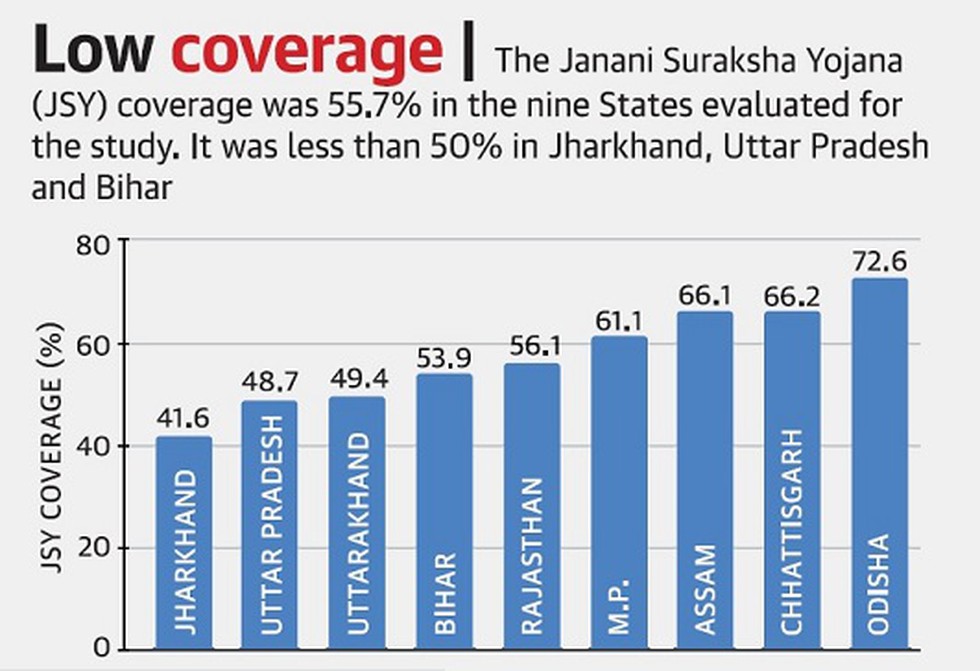Description

Disclaimer: Copyright infringement not intended.
Context
- Poverty, education, and exposure to a community health worker are more important than age at marriage in determining whether a mother will be able to have a safe birth in a medical facility, according to a study on utilisation of institutional delivery in the country - Published in Global Health Action.
Institutional delivery
- Institutional delivery means giving birth to a child in a medical institution under the overall supervision of trained and competent health personnel.
Situation in India
- Institutional deliveries rose across most states in India in the past decade-and-a-half, according to 2020 National Family Health Survey (NFHS).
- Kerala topped the charts: The percentage of institutional deliveries, as found in the latest round of NFHS-5 (2019-20), was 99.8 per cent, same as in NFHS-4 (2015-16).
- The gap between institutional births in urban and rural areas reduced over time, but was a major concern nonetheless.
The recent study
- The study focuses on nine low-performing States (LPS) with high burden of maternal mortality — Assam, Bihar, Chhattisgarh, Jharkhand, Madhya Pradesh, Odisha, Rajasthan, Uttar Pradesh and Uttarakhand.

Findings
- As far as socio-demographic factors are concerned, poverty (1.4 to 3.5) is responsible more than twice as much as age at marriage (.78) in determining whether a woman will seek institutional delivery.
- Education (1.2 to 3.8) is 1.5 times more important than age at marriage.
Other challenges
- Poor Last mile connectivity
- Insufficient transport facilities especially in cases of emergencies
- Lockdown imposed during this Covid-19 pandemic
- Absence of/insufficient skilled birth attendants and basic/comprehensive emergency obstetric care functionality
- Disparity prevails across sub-national regions
- High out-of-pocket payments (OOPs)
Need to promote Institutional deliveries
Maternal Health
- Institutional delivery service utilisation and avoiding births in homes in India is one of the key and proven intervention to improve maternal health and to reduce maternal mortality through provision safe delivery environment.
- Complications that occur during labour, delivery and postpartum period are responsible for a majority of maternal deaths.
WHO Recommendation and Findings
- To reduce the level of maternal mortality, the WHO’s safe motherhood initiative emphasises institutional delivery.
- The World Health Organization has appreciated India for its record-breaking progress in recent years in reducing the MMR by 77.
- But India’s present MMR is below the Millennium Development Goal (MDG) target and puts the country on track to achieve the Sustainable Development Goal (SDG) target of an MMR below 70 by 2030.
Government efforts
Janani Suraksha Yojana
- A central sector scheme. The objective of JSY is to reduce MMR and neo-natal mortality rate (NMR) through promotion of institutional deliveries.
Pradhan Mantri Surakshit Matritva Abhiyan (PMSMA)
- It has been launched to focus on conducting special AnteNatal Check-ups (ANC) check up on 9th of every month with the help of Medical officers to detect and treat cases of anaemia.
Pradhan Mantri Matru Vandana Yojana (PMMVY)
- It is a maternity benefit programme being implemented in all districts of the country with effect from 2017.
LaQshya Programme
- LaQshya (Labour room Quality Improvement Initiative) is intended to improve the quality of care in the labour room and maternity operation theatres in public health facilities.
Way Ahead
- It’s important to emphasize upon the quality of in-facility maternal care and awareness about the importance of reproductive health.
- Furthermore, strengthening sub-national policies specifically in underperforming states is imperative to improve institutional delivery coverage.
- Efficient and increased investment in the public health system (adequate provision of training, recognition, and consistent retention of skilled personnel) at all tiers (specifically strengthening primary level PHCs) is imperative.
https://epaper.thehindu.com/Home/ShareArticle?OrgId=GGQ9B3B6C.1&imageview=0
https://www.downtoearth.org.in/blog/health/institutional-deliveries-on-the-rise-across-most-states-shows-nfhs-5-report-74813











